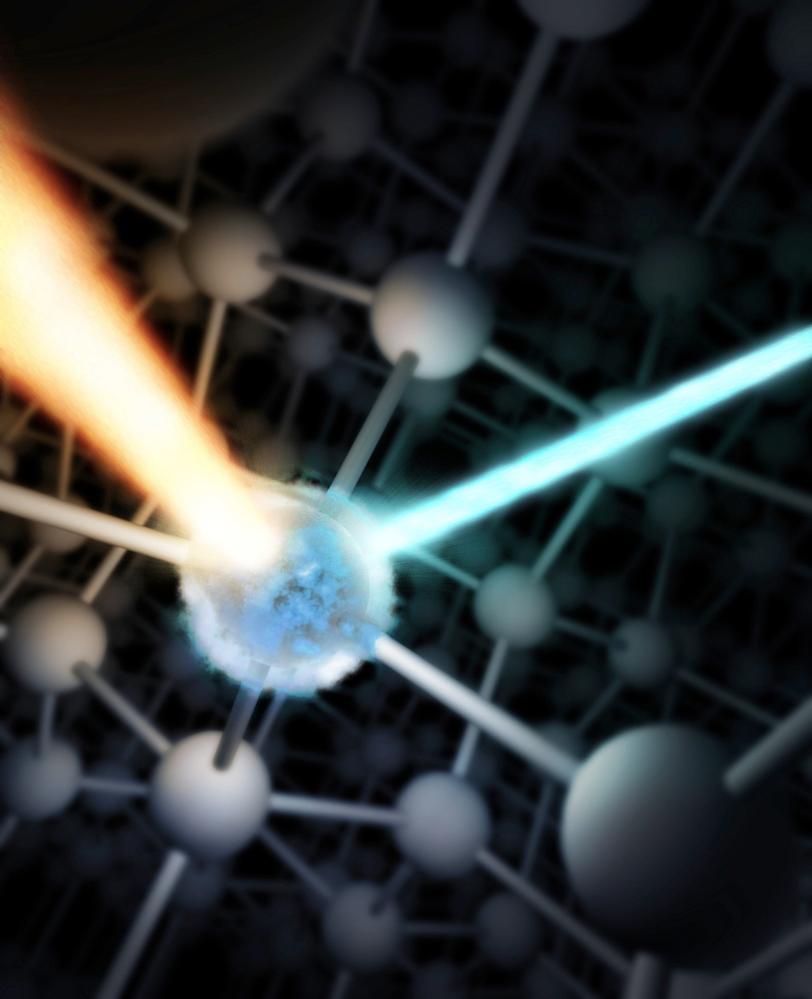Laser Mashup: Researchers Mix X-ray, Optical Beams to Create Atomic Gauge
In a paper published Aug. 30 in Nature, an international team of researchers working at the Linac Coherent Light Source at SLAC National Accelerator Laboratory describe a promising new method that directly measures, in atomic detail, how light manipulates electric charge in a material.
By Glenn Roberts Jr.
In a paper published Aug. 30 in Nature, an international team of researchers working at the Linac Coherent Light Source at SLAC National Accelerator Laboratory describe a promising new method that directly measures, in atomic detail, how light manipulates electric charge in a material.
The technique, which mixes X-ray and optical wavelengths of light, can be used to study light-triggered reactions important to solar energy conversion, advanced materials and advanced integrated circuits.
Until the LCLS opened in 2009, X-ray sources lacked the power to probe and directly observe the details of such interactions.
"The wave-mixing technique was suggested nearly a half century ago but has only recently become feasible, largely because of the high peak brightness of new sources such as LCLS,” said Ernie Glover, a staff scientist at Lawrence Berkeley National Laboratory's Advanced Light Source, who co-led the research team with Jerome Hastings from SLAC.
“By allowing us to directly measure how light rearranges charge in a material, the method provides new data that should help us better understand why a photosensitive material evolves along one pathway rather than along some other," he said.
Hastings, a scientist and professor at SLAC, said, "I have dreamt of carrying out this experiment since first reading a paper by Peter Eisenberger and Samuel McCall, published in 1971, proposing X-ray optical wave mixing. Only with the LCLS did this become possible.
"The hope is that it evolves from the possible to the routine, and we will be able to use X-ray optical wave mixing to gain further insight onto the microscopic properties of matter."
Previously, researchers could measure instantaneous changes in the electrical charges of light-exposed materials only as an average over thousands of atoms. Despite this limitation, experiments with light have provided a wealth of information on atoms, molecules and materials.
But even when laser research was in its infancy more than 40 years ago, scientists pondered the potential benefits of mixing optical lasers with X-rays to achieve a more detailed, atomic-scale view.
"If wave mixing is combined with conventional X-ray imaging methods, it should be possible to see changes in a material with single-atom precision," Glover’s team noted in its report.
In their experiment, the researchers aimed X-ray and optical laser beams at a diamond, chosen because its characteristics are already well known. The two types of light form a new beam inside the diamond that provides information about the chemical bonds and electrical properties of the diamond – data not obtainable with X-ray or optical laser light alone.
This new method can “selectively probe regions of charge in a material that may be of particular interest, such as the chemical bonds in diamond," Glover said. “You can directly probe what light does to initiate a reaction. This creates new opportunities for studying material dynamics."
Now the team is contemplating new research to probe how light interacts with materials such as superconductors, where the atomic-scale interactions are complex and often poorly understood. "X-ray and optical mixing experiments can provide novel data to test our current understanding of how advanced materials behave at the atomic scale," the researchers said.
Glover suggested the technique may one day be used to study how light energy is stored during photosynthesis, or how light triggers reactions in biological molecules such as rhodopsin, a protein in the retina of human eyes that bleaches when exposed to bright light and returns to a purple-red hue in dim light.
While in its early stages, the research serves as a "milestone," Glover said, and may mark a new era that extends valuable techniques developed for longer wavelengths of light into the X-ray regime.
In addition to scientists from Berkeley Lab and SLAC, the team also included researchers from the Institute of Physics in Rennes, France; JILA, a joint institute of the National Institute of Standards and Technology and the University of Colorado, Boulder; University of California, Berkeley; and Stanford University.
